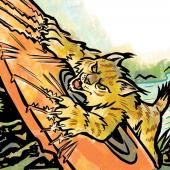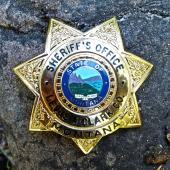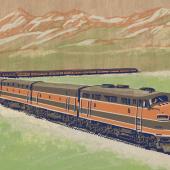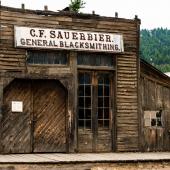Hitchhiking in Montana: A Bygone Era?
My car needed a new clutch at the last minute. Rather than wasting a few days with my favorite climbing partner, Meg Buddle, I left it behind and snagged a ride to Missoula with friends of friends to meet up with her. This was June 2019, when the only pandemics I’d experienced were sealed inside my television screen, with the option to fast-forward or turn them off.
“We’ll just hitch,” Meg said, when I’d asked how we’d reach our campsite.
Hitchhiking is different here in the United States, I explained. I’ve hitched in Montana in certain situations: to the ski hill and back, up the Beartooth Pass for backcountry laps, and back from boating take-outs on the Madison. But it’s not something people from Three Forks do regularly, outside of these parameters.
Meg has been bumming rides since Smith Rock, Oregon. In a week, she’ll thumb to Canada for a mountaineering trip in the Bugaboos, and I’ll return to Bozeman. At 26, a few years younger than I am, Meg is a dumpster diver, veteran alpinist and trad climber, and ultrarunner. She’s also an environmental lawyer. She grew up on a commune near the Coromandel of New Zealand, where hitchhiking is no big deal.
????
I meet Meg at a coffee shop in Missoula for a slice of cherry pie. Fortified, we head out in the rain to stand on the on-ramp. The first guy we thumb stops. Meg and I nod at each other, and I feel a knot ease in my stomach. This rain is nothing—we’ve run miles down slick mountain trails in worse.
Eddie, heading home from a shift at Target, drops us off outside of Lolo, where he thinks we’ll be able to find a ride onwards. It’s the kind of rain where, every now and then, you hear a great rush of water as though someone angry is dumping buckets. Now, no one stops.
Meg and I stand roadside for over an hour. We’re on Highway 93 and need to cover 20 miles, plus a few more on a service road to our campsite. We plan to hike and explore running trails in Lolo National Forest for the next week. We’ve got groceries and a 24-rack of a heinous beer only a Kiwi would buy called Keystone Light, also known as the Beer of Chill.
Holding my thumb out and being ignored feels worse than being in the rain. I’m thinking, How can you all let us stand here? Then again, I don’t often pick up hitchhikers, apart from fellow recreators, for safety reasons and also because I don’t want to. I prefer driving alone. These folks don’t want to pick up two drenched women, and that’s fine. We wait outside Lolo for two more hours. My pack is semi-waterproof, but my sneakers are soaked. My hair’s wet. I am not feeling chill, and Meg has put on the face she uses when she’s digging deep at the tail end of a gut-busting run.
????
Hitchhiking is certainly not unheard of in the Paradise Valley, despite the fact that we’ve built our lives on self-sufficiency and our isolated vehicles, with services like Uber and Lyft filling in the gaps. Makes sense, when you think about the long-held Montana values of helping your neighbors and contributing to your community. This spirit of interconnectedness is what makes Montana special.
Night falls. We’re sitting on wet packs. It’s a vulnerable feeling, asking the world for something and being witnessed not quite receiving it. Serves me right for not picking people up. I’ve broken the karmic chain. Meg and I don’t talk.
Hitching seems to imply to others that you’re not like them. You’re a different kind of person. Less savory, maybe, or for whatever reason an outsider. You become aware of how exposed you are. Especially as a woman. Even more so, I bet, if you don’t appear to be white, able-bodied, cisgendered, or straight.
Finally, a dented black Tundra slows and pulls off the road ahead of us, as if they weren’t sure until the last moment that they wanted to stop.
????
What does it say about Montana if we can’t trust our own communities? Often, the danger is in our heads. Spooky stories build on this fear, providing supernatural forces to explain how unsavory hitchhikers sometimes appear—dark shapes on the side of the road, strewn with an otherworldly aura.
Stories percolate of Montana’s most famous ride-snagger: the Black Horse Lake Hitchhiker. Near Great Falls, a Native American man reportedly slams into windshields and vanishes, the ghost of a guy killed while walking on the side of the road. He now paces this stretch, looking out at the starry lake, continuously reliving his demise like some Montanan Sisyphus who cheated death too many times, only to end up inside something worse.
There’s also the account of a football coach at a small Montanan college who picked up a hitchhiker in an odd suit one day after practice. The man asked him to stop the truck and got out. The coach looked back and saw the hitchhiker crawling on all fours like an animal, chasing his truck at inhuman velocity. Others have reported similar encounters.
Still, there have been real-life, ghastly crimes committed against travelers and those who give rides to strangers. My father, Page Anderson, grew up on a ranch outside of Three Forks. “Hitchhiking was fairly prevalent then,” he says. “My buddies and I used to hitch all the time, but then one time a social worker disappeared, after picking up a guy on his way to Yellowstone National Park.” When police caught the killer, a self-described cannibal, in California, he still had the guy’s fingers in his pocket. The guy was carrying around an LSD recipe and a Satanic Bible, which earned him a neat moniker: the Satanic Hippie. “That pretty much shut down our whole hitchhiking thing for a while,” my father says.
????
Meg and I stand up. Inside the Tundra sit a father and his young daughter—ten, maybe twelve years old. “I just couldn’t let you stay out here,” he says. “How long you been waiting?”
“An hour,” Meg says. “Not long.” It had been three.
When they drop us off, it’s still pouring. Apart from an apparently unoccupied camper, we’re the only ones there. “Are you sure you don’t want me to take you back to town?” he says. “You can’t stay out here.”
We tell him we’ll be fine, and the two reluctantly leave us there.
????
In the nostalgic era of Montana hitchhiking, the endeavor seemed to represent a beautiful fluidity: mobility unlinked to money. Traveling on the strength of human connection. Bartering if you could—huckleberries, conversation, a listening ear. And we’ve had our fair share of Montana writers who’ve hitched or written about hitching: Jim Harrison thumbed across the U.S. in the 1960s. Tom McGuane, in Driving on the Rim, writes about a young hitchhiker his narrator Berl meets and tries to help. Maile Meloy writes about a couple picking up hitchhikers on their way back from securing a Christmas tree in her short story, “O Tannenbaum.” Rick Bass first met Terry Tempest Williams while hitching to Ed Abbey’s memorial in Moab, Utah, in the late 1990s.
Experts say people don’t hitchhike as often anymore, but not because of the risk of being assaulted or kidnapped. As more and more households acquired vehicles over the years, and the vehicles themselves became longer lasting, people simply stopped needing to ask for rides.
A New Yorker cartoon by Kaamran Hafeez pictures a car stopping for an apparent hitchhiker. “I don’t need a lift. I was just liking your car,” the man says.
????
Two days later, the same black Tundra rolls up.
“My daughter’s been asking nonstop about you,” he says. “Figured I’d come make sure you’re okay.”
We invite him for noodle soup and a Keystone Light, but he declines. He’s late for dinner with his family, but he wanted to stop by to make sure we were okay.












As I thumbed 287 along Hebgen Lake, traffic was slow. I finally got a ride with 4 self-imposed hippies in a van. Nice folks, shared a beer with me. They dropped me at the entrance to Beaver Creek CG. By now it was late afternoon and was getting dusky.
The traffic seemed to all but stop as I walked toward the Quake Lake visitor center.
I was only ablut 100 yds west of the CG entrance, no traffic. As I walked, I heard gravel crunch under tires behind me. Looking back, I noticed a pickup, with a topper, stopped leaving the CG entrance.
Curious, I watched the truck for a minute, then walked a few steps, then realised the truck was still just sitting there.
While watching, I waved, both hands overhead, in greeting. No response. I walked a few more steps, turned back again & heard two weird "zing" sounds. I look down and was bleeding from my chest/stomach area. I dropped to my knees in shock. Looking up, the truck was pulling out of the CG road and coming toward me, slowly.
I jumped in the shallow barrow pit and laid as close to the ground as I could. After they passed, and a few minutes of waiting, I got up, afraid to assess my injuries. I didn't seem to be hurt badly but it seemed like a lot of blood.
The sun seemed to set quickly, shadows grew long and not many cars were traveling that stretch of road. And of those that were, no one seemed interested in picking up a hitcher with blood on his shirt.
There is almost no shoulder on this section of road, I was standing a good foot & a half inside the white line & the few cars going by appeared to not realize I was even there.
After walking a way, a pickup stopped with a young man & his girlfriend on their way to Dillon for the festivities. (This was the same weekend that the fighter jet crashed into a grain elevator in Dillon during the air show)
They realized my peril and drove me to the Slide Inn.
A call was made to the authorities, an ambulance was dispatched from Ennis & in a little over an hour I was riding to Ennis for treatment. The ambulance attendant was Ron Handlos, first certified PA in Montana. I would later get to know Ron well as my employer provided health care provider.
In Ennis, the Dr may have had a toddy earlier and was hesitant to treat me. He sent me on to Butte.
In the ambulance, Ron determined the shot hit my upper left chest area, and concern for collapsed lung. I seemed physically stable.
OK, here's where it gets a little comical. Once in Butte (St. James) the x-rays showed no internal damage, no damage to organs or major blood vessels.
The bullet, a .22 caliber, hit a rib high in my chest and the bullet followed that rib to my left shoulder-blade area, not far under the skin. The bullet was fragmented and the pieces lay in the muscle just below the shoulder blade.
Treatment? They gave me a tetanus shot & covered the entrance hole with a band-aid.
I hitchhiked once after, From Fairview to Bozeman, just to prove to myself the other incident was not the norm.
- Reply
Permalink